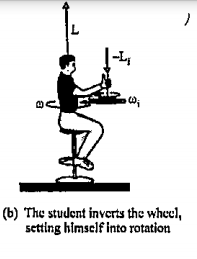Figure shows a student, again sitting on a stool that can rotate freely about a vertical axis. The student, initially at rest, is holding a bicycle wheel whose rim is loaded with lead and whose rotational inertia Iwh about its central axis is 1.2kg⋅m2.
The wheel is rotating at an angular speed ωwh of 3.9 rev/s, as seen from overhead, the rotation is counterclockwise. The axis of the wheel is vertical, and the angular Momentum →Lwh of the wheel points vertically upward.

The student now inverts the wheel so that, as seen from overhead, it is rotating clockwise. Its angular momentum is now −→Lwh. The inversion results in the student, the stool, and the wheel's center rotating together as a composite rigid body about the stool's rotation axis, with rotational inertia Ib=6.8kg⋅m2. With what angular speed ωb and in what direction does the composite body rotate after the inversion of the wheel?
1. The angular speed ωb we seek is related to the final angular momentum →Lb of the composite body about the stool.s rotation axis by (L=Iω).
2. The initial angular speed ωwh of the wheel is related to the angular momentum →Lwh of the wheel.s rotation about its center by the same equation.
3. The vector addition of →Lband→Lwh gives the total angular momentum Ltot of the system of the student, stool, and wheel.
4. As the wheel is inverted, no net external torque acts on that system to change →Ltot about any vertical axis. So, the system.s total angular momentum is conserved about any vertical axis, including the rotation axis through the stool.
Calculations: The conservation of →Ltot is represented with vectors in Fig. We can also write this conservation in terms of components along a vertical axis as
Lbf+Lwh.f=Lb,i+Lwh,i.
Where i and f refer to the initial state and the final state. Because inversion of the wheel inverted the angular momentum vector of the wheel.s rotation, we substitute −Lwh,i for Lwh,f. Then, if we set Lb,i=0.
Lb,f=2Lwh,i.
Using Equation, we next substitute Ibωb for Lb.fandIwhωwh for Lwh,i and solve for ωb, finding
ωb=2IwhIbωwh
= (2)(1.2kg⋅m2)(3.9rev/s)6.8kg⋅m2=1.4rev/s.
Topper's Solved these Questions
- RIGID BODY DYNAMICS - IBOOK - RESNICK AND HALLIDAYCHAPTER - RIGID BODY DYNAMICS - IEXERCISE - CHECKPOINT
18 Videos
- RIGID BODY DYNAMICS - IBOOK - RESNICK AND HALLIDAYCHAPTER - RIGID BODY DYNAMICS - IEXERCISE - PROBLEMS
100 Videos
- RELATIVITYBOOK - RESNICK AND HALLIDAYCHAPTER - RELATIVITYEXERCISE - PRACTICE QUESTIONS (Integer Type)
5 Videos
- RIGID BODY DYNAMICS-IIBOOK - RESNICK AND HALLIDAYCHAPTER - RIGID BODY DYNAMICS-IIEXERCISE - PRACTICE QUESTIONS (Integer Type)
2 Videos
Similar Questions
Figure shows a student, sitting on a stool that can rotate freely about a vertical axis. The student, initially at rest, is holding a bicycle wheel whose rim is loaded with lead and whose moment of inertia is I about its central axis. The wheel is rotating at an angular speed ωi from an overead perspective, the rotation is counter clockwise. The axis of the wheel point vertical, and the angular momentum →Li of the wheel points vertically upward. The student now inverts the wheel, as a result, the student and stool rotate about the stool axis. With what angular speed and direction does the student then rotate? (The moment of inertia of the student+stool+wheel system about the stool axis is I0)


View SolutionA wheel of moment of inertia I and radius R is rotating about its axis at an angular speed ω. It picks up a stationary particle of mass m at its edge. Find the new angular speed of the wheel.
View Solution
Knowledge Check
A wheel is rotating freely at an angular speed of 800 rev/min on a shaft whose rotational inertia is negligible. A second wheel initially at rest with thrice the rotational inertia of the first is suddenly coupled to the same shaft. The fraction of original kinetic energy lost is
A23B13C14D12Kinetic energy of a wheel rotating about its central axis is E. Then kinetic energy of another axis is E. Then kinetic energy of another wheel having twice the moment of inertia and half the angular momentum as that of the first wheel is
A8 EB4 ECE/8DE/4
A wheel is rotating at an angular speed ω about its axis which is kept vertical. An identical wheel initially at rest is gently dropped into the same axle and the two wheels start rotating with a common angular speed. Find this common angular speed.
View SolutionA wheel of moment of inertial I and radius R is rotating about its axis at an angular speed ω. It picks up a stationary particle of mass m at its edge. Find the new angular speed of the wheel.
View SolutionA wheel of moment of inertial I and radius R is rotating about its axis at an angular speed ω. It picks up a stationary particle of mass m at its edge. Find the new angular speed of the wheel.
View SolutionA wheel is rotasting ast an angular speed ω about its axis which is kept vertical. An identical wheel initially at rest is gently dropped into the sae axle and the two wheels start rotating with a common angular speed. Find this common angular speed.
View SolutionA wheel rotating at an angular speed of 20 rad/s ils brought to rest by a constant trouque in 4.0 secons. If the moiment of inertia of the wheel about the axis of rotation is 0.20 kg−m2 find the work done by the torque in the first two seconds.
View SolutionThe rotational inertia of a disc about its axis is 0.70 kg m2. When a 2.0 kg mass is added to its rim, 0.40 m from the axis, the rotational inertia becomes
View Solution
